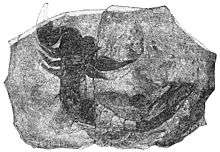Palaeophonus
| Palaeophonus Temporal range: Wenlock–Early Devonian | |
|---|---|
| | |
| Model of Palaeophonus nuncius | |
| Scientific classification | |
| Kingdom: | Animalia |
| Phylum: | Arthropoda |
| Class: | Arachnida |
| Order: | Scorpiones |
| (unranked): | Protoscorpiones |
| Genus: | † Palaeophonus Thorell & Lindström, 1884 |
Palaeophonus (meaning ancient killer) is the oldest known genus of scorpion.[2]
Fossil records

This genus is known in the fossil record from the Silurian to the Carboniferous (age range: 428.2 to 314.6 million years ago). Fossils have been found in Europe, United States and Canada.[3]
Description
Palaeophonus was virtually identical to modern scorpions. It grew to a lengths of 2.5–3.5 inches (64–89 mm). [4] These animals did not have eyes and therefore they were blind. [5]
Until a few decades ago it was thought that Palaeophonus, similarly to many other scorpions of the Silurian, was one of the earliest animals to have conquered the land. In fact, a closer examination of the fossils has determined that these animals possess well developed gills, very similar to those of contemporary Eurypterids (or sea scorpions). [6]
It is likely, therefore, that Palaeophonus and its relatives were water scorpions, living in the estuaries to hunt small prey. In any case, it is highly likely that these animals reached from time to time the mainland [7] and would have preyed upon small creatures that lived alongside it, including primitive springtails and millipedes.
Species

Species within this genus include: [3]
- †Palaeophonus arctus Matthew 1894
- †Palaeophonus lightbodyi Kjellesvig-Waering 1954
- †Palaeophonus nuncius Thorell and Lindström 1884
- †Palaeophonus osborni Whitfield 1885
References
- ↑ Laurie, M. (2012). "XIX.—On a Silurian Scorpion and some additional Eurypterid Remains from the Pentland Hills". Transactions of the Royal Society of Edinburgh. 39 (3): 575. doi:10.1017/S0080456800035109.
- 1 2 Dunlop, J. A. (2010). "Geological history and phylogeny of Chelicerata". Arthropod Structure & Development. 39 (2–3): 124. doi:10.1016/j.asd.2010.01.003.
- 1 2 Paleobiology Database
- ↑ G. A. Polis The Biology of scorpions
- ↑ The Eurypterida of New York Volume 1.pdf/408
- ↑ Alexander Petrunkevitch Paleozoic and Mesozoic Arachnida of Europe
- ↑ Ellie Zolfagharifard Ancient scorpion reveals its land legs: 430 million-year-old fossils suggest the sea creatures may have walked out of the ocean
- Steve Parker (2003). Dinosaurus: the Complete Guide to Dinosaurs. Firefly Books. p. 75. ISBN 978-1-55297-772-9.
- Frank H.T. Rodes, Herbert S. Zim en Paul R. Shaffer (1993) - Natuurgids Fossielen (het ontstaan, prepareren en rangschikken van fossielen), Zuidnederlandse Uitgeverij N.V., Aartselaar. ISBN D-1993-0001-361